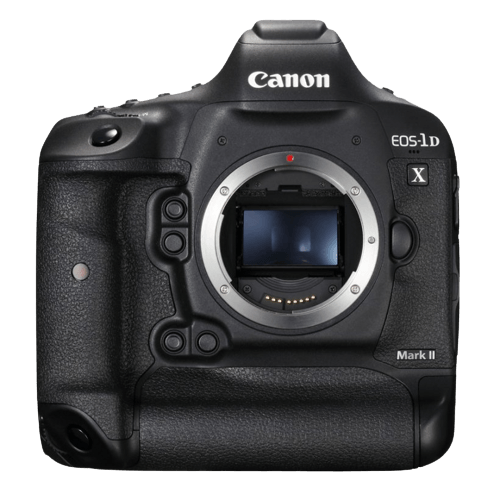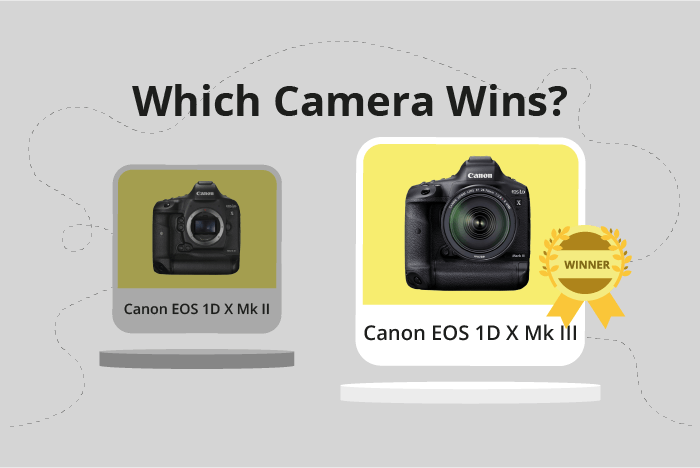Canon EOS 1D X Mark II vs EOS 1D X Mark III Comparison
Canon EOS 1D X Mark II

Canon EOS 1D X Mark III

The Canon EOS 1D X Mark III emerges as the winner with a score of 75/100, a slight lead over the Canon EOS 1D X Mark II, which scored 73/100. Both cameras are DSLRs and share the same dimensions (158 x 168 x 83mm) and launch prices ($6,000 for Mark II and $6,500 for Mark III).
The Mark III has the advantage of being a newer model, released in 2020, which gives it a fresher approach to technology compared to the 2016 release of the Mark II. The winning camera also boasts a significant weight reduction, weighing in at 738g (1.63lbs), making it easier to carry and handle compared to the Mark II’s 1530g (3.37lbs) weight.
However, the Mark II might still appeal to some photographers due to its lower launch price. Despite the difference in scores, both cameras offer great quality and performance, making them suitable for various photography needs. The choice ultimately depends on individual preferences and budget considerations.
Canon EOS 1D X Mark II vs EOS 1D X Mark III Overview and Optics
The Canon EOS 1D X Mark III wins the optics comparison with a score of 74/100, while the Canon EOS 1D X Mark II scores 72/100. Both cameras share several specifications, including a full-frame CMOS sensor, Canon EF lens mount, and lack of image stabilization. However, there are differences that set the Mark III apart as the better camera.
The Mark III’s advantages include a faster shooting speed of 20 frames per second (fps) compared to the Mark II’s 16 fps. This enables the Mark III to capture fast-moving subjects more efficiently. Additionally, the Mark III has a superior processor, the Digic X, which contributes to its improved performance. The Mark III also boasts a higher DXOMARK score for its sensor at 91, compared to the Mark II’s score of 88, indicating better overall image quality.
The Mark II has a slightly higher megapixel count of 20.2, compared to the Mark III’s 20.1, but this difference is negligible and does not significantly impact image quality. As such, the Mark II does not hold a clear advantage over the Mark III in any aspect of optics.
Considering these points, the Canon EOS 1D X Mark III is the better camera in terms of optics due to its faster shooting speed, advanced processor, and higher sensor score. The Mark II does not offer any notable advantages over the Mark III. Thus, for photographers seeking superior optical performance, the Canon EOS 1D X Mark III is the clear choice.
Canon EOS 1D X Mark II vs EOS 1D X Mark III Video Performance
The Canon EOS 1D X Mark III outperforms the Canon EOS 1D X Mark II in video capabilities, with a difference of 22 points in their video scores – 91/100 and 69/100, respectively. Both cameras share common specifications, such as 4K maximum video resolution and 4096 x 2160 maximum video dimensions.
The 1D X Mark III surpasses its predecessor in two significant aspects. First, it has a maximum video frame rate of 120fps, doubling the 1D X Mark II’s 60fps. This higher frame rate allows for smoother and more detailed slow-motion footage, making the 1D X Mark III more versatile for various video applications. Second, the 1D X Mark III features built-in time-lapse functionality, which the 1D X Mark II lacks. This addition enables photographers to create stunning time-lapse videos without needing external equipment or software.
On the other hand, the 1D X Mark II does not have any video features that are superior to the 1D X Mark III. Its lower video score reflects this fact, as it lacks the advanced frame rate and time-lapse functionality found in the newer model.
Evaluating both cameras’ video capabilities, it is clear that the Canon EOS 1D X Mark III is the superior choice for photographers and videographers who require high-quality video performance. Its higher video score, doubled frame rate, and built-in time-lapse functionality make it a more capable and versatile camera for capturing professional-grade video content.
Canon EOS 1D X Mark II vs EOS 1D X Mark III Features and Benefits
The Canon EOS 1D X Mark III wins in the features comparison with a score difference of 22 points. Both cameras have a 3.2-inch touchscreen and GPS functionality but differ in their screen resolution and connectivity options.
The Canon EOS 1D X Mark II and Canon EOS 1D X Mark III share some specifications. Both cameras have a 3.2-inch touchscreen, making it easy for users to navigate through settings and review images. Additionally, they both have GPS functionality, which is useful for geotagging photos and tracking locations.
The Canon EOS 1D X Mark III is the superior camera in terms of features. Its screen resolution is 2,100,000 dots, which is higher than the Mark II’s 1,620,000 dots. This higher resolution provides a clearer and more detailed image on the screen. The Mark III also has Wi-Fi connectivity, which the Mark II lacks. This allows for easier sharing of images and remote control of the camera through a smartphone or tablet.
On the other hand, the Canon EOS 1D X Mark II does not have any features that make it better than the Mark III. It has a lower screen resolution and lacks Wi-Fi connectivity. These factors contribute to the lower feature score of the Canon EOS 1D X Mark II.
As a result, the Canon EOS 1D X Mark III is the clear winner in this comparison. Its higher screen resolution and Wi-Fi connectivity make it a more versatile and user-friendly camera. The Canon EOS 1D X Mark II, while still a powerful camera, falls short in comparison due to its lower screen resolution and lack of Wi-Fi.
Canon EOS 1D X Mark II vs EOS 1D X Mark III Storage and Battery
The Canon EOS 1D X Mark III outperforms the Canon EOS 1D X Mark II in storage and battery, scoring 87/100 compared to 79/100. Both cameras share some common specifications, such as having two memory card slots and using the LP-E19 battery type. Neither camera offers USB charging.
The 1D X Mark III excels with its impressive battery life of 2850 shots, which is more than double the 1D X Mark II’s 1210 shots. Additionally, the Mark III supports the CFexpress Type B memory card, which provides faster read and write speeds compared to the Mark II’s Compact Flash and CFast 2.0 memory cards.
On the other hand, the 1D X Mark II has the advantage of accepting both Compact Flash and CFast 2.0 memory cards, offering more flexibility in storage options. However, this benefit is outweighed by the superior battery life and faster memory card support of the 1D X Mark III.
Ultimately, the Canon EOS 1D X Mark III is the better choice for storage and battery performance, ensuring longer shooting sessions and quicker data transfer.
Canon EOS 1D X Mark II vs EOS 1D X Mark III – Our Verdict
Are you still undecided about which camera is right for you? Have a look at these popular comparisons that feature the Canon EOS 1D X Mark II or the Canon EOS 1D X Mark III:

